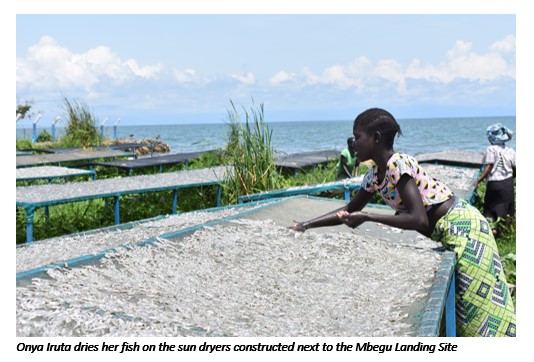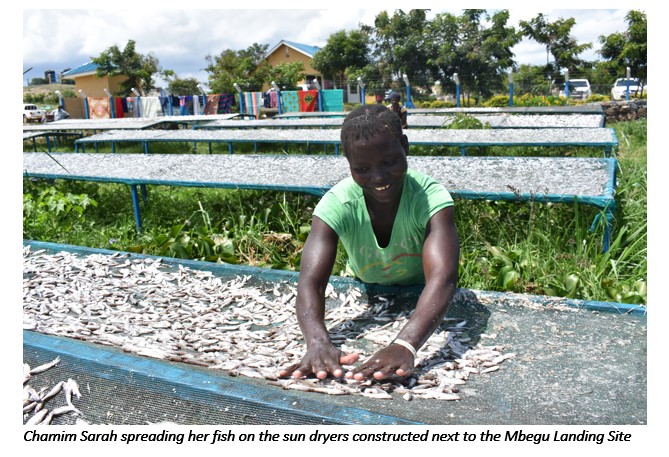“On these modern drying racks, muziiri (silverfish) dries faster, is clean, healthy and people are interested in buying and eating it because its quality is higher,” says Onya Iruta, a fish trader from Mbegu landing site on Lake Albert, Uganda. “Since we started using these modern racks, it takes only a day or a day and a half for the fish to dry, it smells better and tastes better,” Onya Iruta adds. She explains that previously they used to dry muziiri on the ground and it took 2-3 days to dry, was always contaminated with soil, and had low value in the market so they often sold it as chicken feed.
 “Nowadays we have a lot of customers and the muziiri prices are better, because when dried on the racks the fish are whitish in color, while those dried on the ground are usually brownish and our customers know the difference,” says Chamim Sarah. “Actually, I never used to eat muziiri, however my family and I presently enjoy muziiri very much!” adds Sarah. Sarah, a mother of five, is both a wholesaler and a retailer of the silver fish. She is based at Mbegu landing site. She sells 1 cup of silverfish to the local community for 1,00o UGX (0.2USD) and a small basin to fish traders for 40,000 UGX (11.3 USD). Sarah explains that even if it rains, while on the racks, their fish doesn’t get spoiled so customers still come, unlike before when they never came whenever it rained.
“Nowadays we have a lot of customers and the muziiri prices are better, because when dried on the racks the fish are whitish in color, while those dried on the ground are usually brownish and our customers know the difference,” says Chamim Sarah. “Actually, I never used to eat muziiri, however my family and I presently enjoy muziiri very much!” adds Sarah. Sarah, a mother of five, is both a wholesaler and a retailer of the silver fish. She is based at Mbegu landing site. She sells 1 cup of silverfish to the local community for 1,00o UGX (0.2USD) and a small basin to fish traders for 40,000 UGX (11.3 USD). Sarah explains that even if it rains, while on the racks, their fish doesn’t get spoiled so customers still come, unlike before when they never came whenever it rained.
According to the Regional Catch Assessment Survey (CAS) of 2021 commissioned by NELSAP-CU and conducted by the National Fisheries Resources Research Institute (NaFIRRI) in Uganda and the National Service for the Promotion and Development of Fisheries (SENADEP) of the D.R Congo, Lake Albert is dominated by two small pelagic fish species. The survey shows that the two small fish species Engraulicypris bredoi and Brycinus nurse, account for 56% of all fish catch on the lake, and have annual gross beach value of USD 63.2 million on the Ugandan side. The report further noted that there was inadequate appropriate facilities for post-harvest handling and processing of the small fish species, with the bulk of the catch processed on bare ground, exposing the fish to contamination and hence rejection for human consumption. The report proposed development measures targeting value addition for these small fish species to promote them for human consumption rather than their current predominant use as animal feed. It is for this reason that LEAF II project, included sun dryers as part of the modern integrated landing sites on the Ugandan side of Lake Albert, specifically targeting the small fish common on the lake.
 “The sun dryers are the most popular facility on the landing sites on Lake Albert and their inclusion into the design of modern landing site was very deliberate and if used properly the value of the fish can easily double immediately,” says Mr. Richard Rugadya, National Fisheries Officer for LEAF II Project in Uganda.
“The sun dryers are the most popular facility on the landing sites on Lake Albert and their inclusion into the design of modern landing site was very deliberate and if used properly the value of the fish can easily double immediately,” says Mr. Richard Rugadya, National Fisheries Officer for LEAF II Project in Uganda.
The Multinational Lakes Edward and Albert Integrated Fisheries and Water Resources (LEAF II) project of NELSAP/NBI is funded by the African Development Bank (AfDB) and the Global Environment Facility (GEF) and implemented in collaboration with the Governments of the D.R Congo and Uganda.
Chamim Sarah spreading her fish on the sun dryers constructed next to the Mbegu Landing Site.

